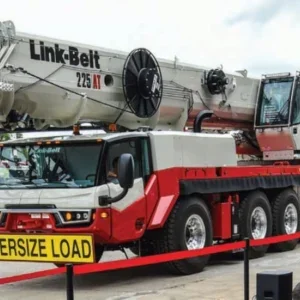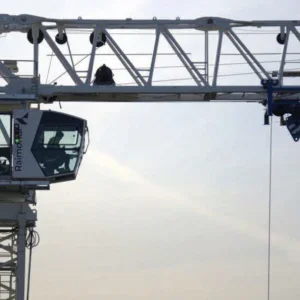Gone are the days when a crane operator pushes a hydraulic lever. As a result, cranes are safer and easy to drive, says Morten Møller, UK manager of component and controller manufacturer Sensor-Technik Wiedemann. Operators do not risk having pipes carrying high-pressure oil between their legs.
Computer systems have replaced these levers with joysticks. The system that connects the joystick to hydraulic cylinder is growing ever more computerised. The signals that the joystick generates travel over a data network based on the CAN (Controller Area Network) communications protocol until they reach a controller, which receives information from sensors around the crane, makes decisions based on that data, and sends out instructions to devices like actuators on hydraulic cylinders. ‘The CAN-Bus is the lifelineof the machine. It interconnects devices spread over the machine,’
says Liebherr Nenzing electronics engineer Josef Schmid.
The devices in this simple network – joystick, controller, sensor, solenoid – are growing ever more intelligent, more communicative, and more autonomous.
That means cranes are getting better. For example, Liebherr Nenzing’s Litronic system can be configured to program swing and boom hoist limits, outreach limitation, rope pay-out metering, winch synchronization, a ground-pressure gauge, and further options for duty-cycle work. Developed in-house, it was introduced four years ago on the range of crawler cranes, ship cranes, dockside cranes and offshore cranes.
Electronic control systems can also increase performance and/or cut manufacturing costs. Electronic controls made for telehandler manufacturers Manitou and Merlo, for example, can help cut weight by reducing safety factors on components. ‘If this is controlled electronically manufacturers can produce cheaper vehicles that can also have the same functionality and features,’ says Bosch Rexroth mobile electronics product manager Sigurd Misselwitz.
Neither hydraulics nor the computers are particularly new. What is recent is the way they co-ordinate. ‘We’ve had electronics mounted on valves for more than 10 years,’ says Dan Ricklefs, a product manager at hydraulics and controls manufacturer Sauer Danfoss. ‘The fact that the valve is now a node on the network – that is a year or two old.’ Ricklefs refers to the PVG 32 product, which comes with a CAN-Bus option.
‘From a communications standpoint, they can exchange more data,’ Ricklefs says. ‘There are diagnostics on the valve. Messages can be sent back to the control system and then back to operator and service technician.
The valves can communicate with the engine. For example, you can have the machine run in a mode optimised for low noise. You would have a minimum engine speed to keep the noise down, and maybe increased stroke of pump
or spool of valve to make up for the lower valve pressure. There is a lot of
co-ordination that can happen there.’
More and more components for heavy equipment are being built to run on the standard CAN protocols, says STW’s Møller. ‘You, as a customer, can buy a module from manufacturer A and put it together with a module from manufacturer B, and get them to talk without difficulties.’
As a result, heavy equipment manufacturers are building the control systems for their vehicles out of lots of little parts from many different manufacturers, rather than one sole supplier (CT July, p31). ‘You no longer get locked in to one company,’ Møller says. STW supplies components to Korea’s Soosan Heavy Industries, Liebherr Ehingen, and Grove, for the GMK 5100.
What CAN cannot doThere are several ‘buts’ here. First, devices can only communicate if they speak the same language – the Can Bus protocol is preferred in the states, and a variant – Can Open is preferred in Europe, according to Sauer Danfoss’s Ricklefs.
Also, sensors wired in to a CAN network may not meet stringent European safety standards, especially for machines lifting people, according to HAWE Hydraulik lead programmer Paul Siegel, who has worked prototyping aerial work platforms with CAN-Bus sensor systems. His solution is to double-up sensors. Even if superior new technology exists, its high prices can put buyers off a completely digital system.
‘A pressure sensor is 50 Euros. A CAN-Bus one is 150 Euros, and a CAN-Bus Safe one is 300 Euros. Cranes must not be expensive. So we will use two analogue ones instead,’ Siegel says.
For the LR crawler cranes, Liebherr Nenzing’s Litronic control system compares two independent sensors in boom angle, luffing cylinder force sensors and sensors in the slewing gear. Nenzing makes most of its own components partly because many sensors have a reaction time that can change.
CAN-Bus was originally developed for devices like engine gauges that only receive a signal and do not feed back to the system, Nenzing’s Schmid says. But if you plug such a component into the system, the entire system suffers. ‘If you have components that have the same protocol, and the same time delays for answers, it is possible to make an optimised control system between the hydraulics and the engine.’
Components are getting smarter, and speaking the same language. But they still need to be told exactly what to do in what circumstances – stopping a winch from spooling more rope when the anti-two block device has been activated, for example. This is the job of the programmable logic controller (PLC).
In March, Bosch Rexroth launched a new range of controllers with more outputs – the RC 44, 69 and 1218, which join the RC 22 released a year ago. The most powerful controller, the RC1218, offers 12 proportional outputs and 18 digital outputs. This family replaces the MC6,7 and 8.
‘Some producers tend to centralise their electronics in a single ECU, so we need some more capacity,’ says product manager Misselwitz.Controlling the controllerThe controllers still require the same programming as before. But the way that programming is done has begun to change. In the old days, the systems would require a program written in a language like C or C++. The company that provided the controls would write software to control them.
Some have carried on that way. HAWE Hydraulik still primarily advises customers to have software custom written. ‘For things like additional display and radio controllers, a simple CAN-Bus system works well. But, to make a crane work properly, you need very good valves and good electronics controlling these valves. Their communication needs to be optimised for the best crane function,’ Siegel says.
But as manufacturers build up control systems from components from many vendors, non-technical computer software that can program the controller without requiring programming expertise has begun to appear. ‘All manufacturers like to be unique,’ says Marco Nicolini, sales manager of Italian controls and load moment indicator manufacturer 3B6.
His company’s offering comes with PC software based on the standard IEC 61131-3 interface, for programming PLCs (the company’s load-moment indicator cannot be modified). HAWE and STW offer similar software. Most offer a library of standard functions to speed up programming.
3B6 supplies complete control systems for some small-volume crane manufacturers including truck-mounted crane manufacturer Stern, Australian yard crane manufacturer Terex Franna, Marchetti’s MG 90.4 and MG 120.5 ATs and Isoli’s military M60 truck crane.
In March, Sauer Danfoss launched a range of hydraulic and electronic controllers called Plus 1. Plus 1 works with both CAN-Open and CAN-Bus.
‘We consider ourselves to be a systems supplier. Electronics are more and more key to a systems solution,’ says Ricklefs.The system uses a graphical development software called Guide that Ricklefs claims is suitable for non-programmers. ‘What we were trying to do is capitalise on the small and mid size manufacturers, who have manual levers on valves. These manufacturers are under pressure to offer the same features as the big guys, the OEMs who have their own electronics organisations,’ he says.
The company is launching a new release of software including more graphic terminal support, and hydraulics that ‘leverage the Plus 1 communication concept’ at the Conexpo show in March next year, Ricklefs says.
A further example of the spread of do-it-yourself programming systems comes from PAT, which two years ago launched a digital control system called iFLEX. In March, PAT launched a programming aid for crane system set-up.
The WinMK4 enables PAT representatives to input the type of crane, type of LMI, load curves, and other performance specifications. The system can also duplicate equipment configurations to simplify data input. PAT supplies Grove in the USA, National Crane and Manitex, and also offers controllers to
Terex Demag, among others.
Still, so far the component manufacturers have had little success breaking into the high-volume crane market. Liebherr Nenzing, for example, manufactures 80 to 90% of its own components partly because of supply issues. ‘It is important for the spare parts supply. The lifetime of the machine is a lot higher than the lifespan of electronic devices’, Schmid says.
Says Sauer Danfoss’s Ricklefs: ‘We have supplied systems for telehandlers and aerial platforms. My impression is that crane manufacturers have always done their own stuff.’
Møller of STW reports that Terex Cranes and Tadano Faun are interested, and even prototyping with ESX, but none are yet in production. The company supplies joysticks, controllers, control software and hydraulic pressure sensors for some Grove mobile cranes
Adds HAWE’s Siegel: ‘We are trying to get into the crane market, but there are problems with the big customers who have own electronic development departments. It is not so easy to get in.’






